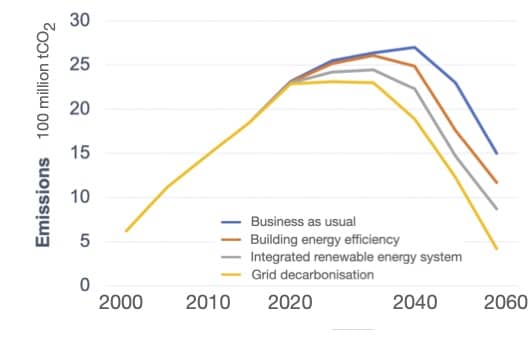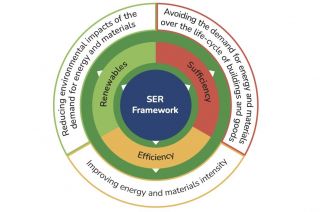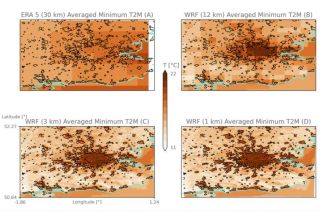
www.buildingsandcities.org/insights/commentaries/cop26-china.html
What China's Carbon Neutrality Means for its Building Stock

By Wei Yang and Jie Li (Tianjin University, CN)
China's pledge to become carbon neutral will have profound effects on its existing and new buildings. Scalable scenarios from national to district levels have been created to begin a process of assessing and apportioning carbon budgets. A range of new economic, social and technical measures will be needed to achieve this radical transformation.
In June 2015, China provided its Nationally Determined Contribution to the Paris Agreement: its overall carbon emissions would peak around 2030 (Department of Climate Change, National Development and Reform Committee of China, 2015). At the end of 2020, President Xi Jinping (2020) stated China's new national goal of carbon neutrality: to become carbon neutral before 2060 with a peak in carbon emissions before 2030 and more than 65% reduction per GDP carbon intensity (based on the 2005 level). Roadmaps for fulfilling those overarching goals have been planned at national, regional, and urban levels, and even for each urban district.
Buildings and the built environment contribute about half of the China's total carbon emissions. Building operation accounts for about 22% of the national energy-related emissions, whereas the embodied emissions in the construction materials, construction operations along with associated transport contributes a further 28% of the national total.
The main strategies for reaching carbon neutrality in the building stock include increasing the energy efficiency of the new and existing buildings, extensive application of building integrated renewable energy, decarbonization of the energy sources (mainly the grid electricity), electrification of the building energy system, and the carbon sink of natural vegetation and water bodies (Figure 1). Moreover, carbon capture & storage will facilitate the last step to reach the carbon neutrality goal (China Association of Building Energy Efficiency, 2020).
Scenario studies had shown that strict measures should be taken immediately in order to keep the temperature rise within 1.5 oC and to reach carbon neutrality by 2060. The construction rate of new buildings (about 4 billion m2 per year) has remained steady in the recent years (National Bureau of Statistics of China, 2020). It is expected that the building stock will grow at the same rate in the next decade in the business-as-usual scenario. In order to reach the carbon neutrality targets, all new and existing buildings will need to be zero carbon in the operational stage, which means a vast amount of investment. The roadmap studies for peak carbon and carbon neutrality at smaller scale had shown dilemmas for future new construction and the carbon reduction goals. Although the national targets do not simply scale down evenly to each individual district, there is still a need to restrict the amount of new construction and at the same time improving the sustainability of the existing building stock - approximately 66 billion m2 (China Association of Building Energy Efficiency, 2020). This suggests there will be a great need for energy efficient retrofit in the coming decades (Chen et al., 2020). Therefore, higher education and professional education will gradually emphasise the sustainable management of the existing building stocks and energy efficient / zero-carbon retrofit. Specific programs on those topics are expected to be established in the near future.
Scenario and policy studies had shown that stricter building energy saving targets and standards are needed and a life cycle approach should be applied. China has already issued the Building Carbon Emission Calculation Standard (MOHURD, 2019a) and the Technical Standard for Nearly Zero Energy Building (MOHURD, 2019b). Subsidies are available for ultra-low energy buildings and building integrated renewable energy utilization. The costs of solar PVs had decreased by 80% in the last 10 years. R&D for sustainable building materials also contributes to the reduction of embodied carbon. Carbon trading will be introduced into the building and real estate sector, and this will improve the economic feasibility of zero-carbon buildings and the energy efficient retrofit of existing buildings. Nonetheless, it is more important to consider the carbon emissions of the whole building stock in a long-term and life cycle perspective, and to plan the roadmaps at different scales and different sectors with a holistic understanding of the built environment.
References
Chen, B., Faeste, L., Jacobsen, R., Kong, M.T., Lu, D. & Palme, T. (2020). How China Can Achieve Carbon Neutrality by 2060. https://www.bcg.com/publications/2020/how-china-can-achieve-carbon-neutrality-by-2060
China Association of Building Energy Efficiency. (2020). China Building Energy Research Report [in Chinese] https://www.cabee.org/site/content/24021.html
Department of Climate Change, National Development and Reform Committee of China. (2015). Enhanced Actions on Climate Change: China's Intended Nationally Determined Contributions. https://www4.unfccc.int/sites/submissions/INDC/Published%20Documents/China/1/China%27s%20INDC%20-%20on%2030%20June%202015.pdf
MOHURD (2019a). Building Carbon Emission Calculation Standard (GB/T51366-2019).http://download.mohurd.gov.cn/bzgg/gjbz/GBT%2051366-2019%20%E5%BB%BA%E7%AD%91%E7%A2%B3%E6%8E%92%E6%94%BE%E8%AE%A1%E7%AE%97%E6%A0%87%E5%87%86.pdf
MOHURD (2019b) Technical Standard for Nearly Zero Energy Building (GB/T51350-2019). http://download.mohurd.gov.cn/bzgg/gjbz/GBT%2051350-2019%20%E8%BF%91%E9%9B%B6%E8%83%BD%E8%80%97%E5%BB%BA%E7%AD%91%E6%8A%80%E6%9C%AF%E6%A0%87%E5%87%86.pdf
National Bureau of Statistics of China. (2020). China Statistical Yearbook 2020, Beijing: China Statistics Press. Table 14-23.
Xi, Jiang (2020). Speech at Climate Ambition Summit. https://www.chinadaily.com.cn/a/202012/13/WS5fd575a2a31024ad0ba9b7ac.html
Latest Peer-Reviewed Journal Content
Acceptability of sufficiency consumption policies by Finnish households
E Nuorivaara & S Ahvenharju
Key factors for revitalising heritage buildings through adaptive reuse
É Savoie, J P Sapinski & A-M Laroche
Cooler streets for a cycleable city: assessing policy alignment
C Tang & J Bush
Understanding the embodied carbon credentials of modern methods of construction
R O'Hegarty, A McCarthy, J O'Hagan, T Thanapornpakornsin, S Raffoul & O Kinnane
The changing typology of urban apartment buildings in Aurinkolahti
S Meriläinen & A Tervo
Embodied climate impacts in urban development: a neighbourhood case study
S Sjökvist, N Francart, M Balouktsi & H Birgisdottir
Environmental effects of urban wind energy harvesting: a review
I Tsionas, M laguno-Munitxa & A Stephan
Office environment and employee differences by company health management certification
S Arata, M Sugiuchi, T Ikaga, Y Shiraishi, T Hayashi, S Ando & S Kawakubo
Spatiotemporal evaluation of embodied carbon in urban residential development
I Talvitie, A Amiri & S Junnila
Energy sufficiency in buildings and cities: current research, future directions [editorial]
M Sahakian, T Fawcett & S Darby
Sufficiency, consumption patterns and limits: a survey of French households
J Bouillet & C Grandclément
Health inequalities and indoor environments: research challenges and priorities [editorial]
M Ucci & A Mavrogianni
Operationalising energy sufficiency for low-carbon built environments in urbanising India
A B Lall & G Sethi
Promoting practices of sufficiency: reprogramming resource-intensive material arrangements
T H Christensen, L K Aagaard, A K Juvik, C Samson & K Gram-Hanssen
Culture change in the UK construction industry: an anthropological perspective
I Tellam
Are people willing to share living space? Household preferences in Finland
E Ruokamo, E Kylkilahti, M Lettenmeier & A Toppinen
Towards urban LCA: examining densification alternatives for a residential neighbourhood
M Moisio, E Salmio, T Kaasalainen, S Huuhka, A Räsänen, J Lahdensivu, M Leppänen & P Kuula
A population-level framework to estimate unequal exposure to indoor heat and air pollution
R Cole, C H Simpson, L Ferguson, P Symonds, J Taylor, C Heaviside, P Murage, H L Macintyre, S Hajat, A Mavrogianni & M Davies
Finnish glazed balconies: residents' experience, wellbeing and use
L Jegard, R Castaño-Rosa, S Kilpeläinen & S Pelsmakers
Modelling Nigerian residential dwellings: bottom-up approach and scenario analysis
C C Nwagwu, S Akin & E G Hertwich
Mapping municipal land policies: applications of flexible zoning for densification
V Götze, J-D Gerber & M Jehling
Energy sufficiency and recognition justice: a study of household consumption
A Guilbert
Linking housing, socio-demographic, environmental and mental health data at scale
P Symonds, C H Simpson, G Petrou, L Ferguson, A Mavrogianni & M Davies
Measuring health inequities due to housing characteristics
K Govertsen & M Kane
Provide or prevent? Exploring sufficiency imaginaries within Danish systems of provision
L K Aagaard & T H Christensen
Imagining sufficiency through collective changes as satisfiers
O Moynat & M Sahakian
US urban land-use reform: a strategy for energy sufficiency
Z M Subin, J Lombardi, R Muralidharan, J Korn, J Malik, T Pullen, M Wei & T Hong
Mapping supply chains for energy retrofit
F Wade & Y Han
Operationalising building-related energy sufficiency measures in SMEs
I Fouiteh, J D Cabrera Santelices, A Susini & M K Patel
Promoting neighbourhood sharing: infrastructures of convenience and community
A Huber, H Heinrichs & M Jaeger-Erben
New insights into thermal comfort sufficiency in dwellings
G van Moeseke, D de Grave, A Anciaux, J Sobczak & G Wallenborn
'Rightsize': a housing design game for spatial and energy sufficiency
P Graham, P Nourian, E Warwick & M Gath-Morad
Implementing housing policies for a sufficient lifestyle
M Bagheri, L Roth, L Siebke, C Rohde & H-J Linke
The jobs of climate adaptation
T Denham, L Rickards & O Ajulo
Structural barriers to sufficiency: the contribution of research on elites
M Koch, K Emilsson, J Lee & H Johansson
Disrupting the imaginaries of urban action to deliver just adaptation [editorial]
V Castán-Broto, M Olazabal & G Ziervogel
Nature for resilience reconfigured: global- to-local translation of frames in Africa
K Rochell, H Bulkeley & H Runhaar
How hegemonic discourses of sustainability influence urban climate action
V Castán Broto, L Westman & P Huang
Fabric first: is it still the right approach?
N Eyre, T Fawcett, M Topouzi, G Killip, T Oreszczyn, K Jenkinson & J Rosenow
Social value of the built environment [editorial]
F Samuel & K Watson
Understanding demolition [editorial]
S Huuhka
Data politics in the built environment [editorial]
A Karvonen & T Hargreaves



Latest Commentaries
Decolonising Cities: The Role of Street Naming
During colonialisation, street names were drawn from historical and societal contexts of the colonisers. Street nomenclature deployed by colonial administrators has a role in legitimising historical narratives and decentring local languages, cultures and heritage. Buyana Kareem examines street renaming as an important element of decolonisation.
Integrating Nature into Cities
Increasing vegetation and green and blue spaces in cities can support both climate change mitigation and adaptation goals, while also enhancing biodiversity and ecological health. Maibritt Pedersen Zari (Auckland University of Technology) explains why nature-based solutions (NbS) must be a vital part of urban planning and design.